Anundshög Burial Mound: One Of Sweden’s Richest And Largest Sacred Ancient Sites
A. Sutherland - AncientPages.com - Anundshög is a burial mound from about 500-700 AD; it is 9 meters (30 ft) high and 60 meters (200 ft) wide, and this is the largest burial mound in Sweden.
Anundshög, located near Västerås in Västmanland, Sweden, contains 12 mounds, ten stone circles, 14 standing stones, and one imposing rune stone. There are also five stone ships of various sizes, the largest of which is 53 meters long and 16 meters wide, in the vicinity of the mound.
Image credit: Anundshög
Many believe the area was a significant center of royal power during the Iron Age and was also important around the 1300s. Anundshög was a part of Eric Street (in Swedish: 'Eriksgata'), and several of the stones in the area mark this traditional path through which the chosen king rode past with his escort to get his royal power confirmed by the people.
Many people participated in the building of the Anundshög burial mound in Sweden. It was made of clay and used to burn the dead, whose remains were covered with a cairn of stones, turf, and soil. The remains around Anundshög clearly show that the area was the core of a prestigious power center during the Iron Age.
Although the site contains many graves, people report the positive energies of the place and several healing areas (one of them is the stone ship).
It seems that in early medieval times, someone deliberately tried to wipe out the power center and weaken its importance. The stone ships were destroyed, and a runestone was overthrown.
The original name of the site is not preserved and remains unknown. During the Middle Ages, the site's name was replaced, and since then, all know it as 'Anundshög.'
Left: The runestone at Anundshög has a pattern and a runic inscription, different from other runes in Sweden. Image credit: www.anundshog.se Right: Image credit: Christer Johansson - CC BY-SA 2.5
Were the burial mound and its name associated with the legendary Swedish king Anund ('trail-blazer) Bröt-Anund or 'Anund the Land Clearer' who reigned during the early 600s, or did the name originate from the large runestone at the site?
Anundshög site has 11 smaller burial mounds, most of which were looted a long time ago; there are also ten stone circles between 6 to 30 meters in diameter.
The damage to the site during the 1600s could be related to the advent of Christianity when similar sites were no longer accepted.
Researchers restored four of the five ships, and the fifth ship setting is still to recover.
"Folkvid raised all of these stones after his son Heden, Anund's brother. Vred carved the runes..."
The runestone at Anundshög has a pattern and a runic inscription, different from other runes in Sweden.
"Folkvid raised all of these stones after his son Heden, Anund's brother. Vred carved the runes..."
A man named Folkvid ordered the construction of the stone ships in the 1000s and helped to construct them.
In the middle of the runestone, a man and a woman are depicted, and according to the inscription:
+ fulkuiþr + raisti + stainn + þasi + ala + at + sun + + sin + hiþin + bruþur + anutaR + uraiþr hik + runaR
The runestone was overturned and moss-grown back in the 1660s, according to Runic Inscriptions 'Ransakningarna' 1667.
Tibble maze, used for all kinds of rites and dated to 100's, is located only 800 meters from Anundshög; formed of 2000-3000 stone, it represents one of Sweden's labyrinths, usually used in fertility rituals or to contact the spirit world with the help of shamans, or medicine men.
Written by – A. Sutherland AncientPages.com Staff Writer
Updated on January 27, 2023
Copyright © AncientPages.com All rights reserved. This material may not be published, broadcast, rewritten or redistributed in whole or part without the express written permission of AncientPages.com
Expand for referencesMore From Ancient Pages
-
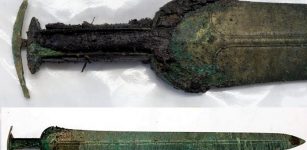 A 1.3 kg Heavy Bronze Sword Unearthed On Funen Island, Denmark
Archaeology | Mar 16, 2021
A 1.3 kg Heavy Bronze Sword Unearthed On Funen Island, Denmark
Archaeology | Mar 16, 2021 -
 Lost Ancient Texts Of The Star Catalogue Composed By The Greek Astronomer Hipparchus Found
News | Feb 21, 2023
Lost Ancient Texts Of The Star Catalogue Composed By The Greek Astronomer Hipparchus Found
News | Feb 21, 2023 -
 On This Day In History: Famous American Author Edgar Allan Poe Found Dying – On Oct 3, 1849
News | Oct 3, 2016
On This Day In History: Famous American Author Edgar Allan Poe Found Dying – On Oct 3, 1849
News | Oct 3, 2016 -
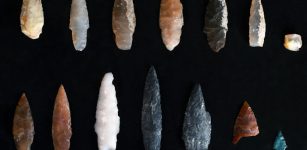 Oldest Known Projectile Points In The Americas Discovered In Idaho
Archaeology | Dec 23, 2022
Oldest Known Projectile Points In The Americas Discovered In Idaho
Archaeology | Dec 23, 2022 -
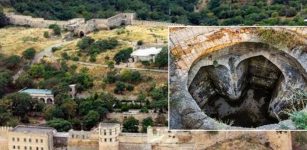 Subterranean Structure In Medieval Naryn-Kala Citadel: Was It The Christian Temple?
Archaeology | Jul 12, 2019
Subterranean Structure In Medieval Naryn-Kala Citadel: Was It The Christian Temple?
Archaeology | Jul 12, 2019 -
 New Details On Discovery Of San Jose 300-Year-Old Shipwreck That Sank With Treasure Of Gold, Silver, And Emeralds
Archaeology | May 23, 2018
New Details On Discovery Of San Jose 300-Year-Old Shipwreck That Sank With Treasure Of Gold, Silver, And Emeralds
Archaeology | May 23, 2018 -
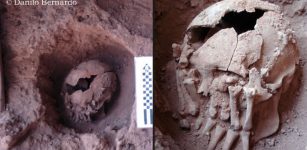 Oldest Case of Decapitation In the New World – Lapa do Santo, East-Central Brazil
Civilizations | Sep 24, 2015
Oldest Case of Decapitation In the New World – Lapa do Santo, East-Central Brazil
Civilizations | Sep 24, 2015 -
 The Truth About Ancient Rome’s Vomitorium
Featured Stories | Jun 18, 2019
The Truth About Ancient Rome’s Vomitorium
Featured Stories | Jun 18, 2019 -
 Neanderthals Hunted Dangerous Cave Lions In Eurasia – New Study Shows
Archaeology | Oct 12, 2023
Neanderthals Hunted Dangerous Cave Lions In Eurasia – New Study Shows
Archaeology | Oct 12, 2023 -
 New Interpretation Of The Domesday Book Of William I The Conqueror
News | Jan 16, 2021
New Interpretation Of The Domesday Book Of William I The Conqueror
News | Jan 16, 2021 -
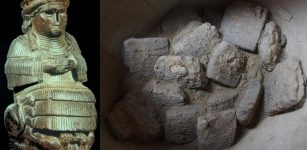 Sensational Find: Huge Cuneiform Archive Of Mysterious Ancient Clay Tablets Discovered In Iraq
Archaeology | Oct 26, 2017
Sensational Find: Huge Cuneiform Archive Of Mysterious Ancient Clay Tablets Discovered In Iraq
Archaeology | Oct 26, 2017 -
 Roman Marble Head Found In Lake Nemi Could Be From Caligula’s Legendary Ships
Archaeology | Jun 28, 2023
Roman Marble Head Found In Lake Nemi Could Be From Caligula’s Legendary Ships
Archaeology | Jun 28, 2023 -
 Search For Noah’s Ark Continues – The ‘Inside Mount Ararat’ Research Project
Featured Stories | May 4, 2014
Search For Noah’s Ark Continues – The ‘Inside Mount Ararat’ Research Project
Featured Stories | May 4, 2014 -
 Meet The First Neanderthal Family And Community
Archaeology | Oct 19, 2022
Meet The First Neanderthal Family And Community
Archaeology | Oct 19, 2022 -
 Baffling Unexplained ‘Alien’ Condition – Evidence Of Unknown DNA?
Featured Stories | Jan 6, 2021
Baffling Unexplained ‘Alien’ Condition – Evidence Of Unknown DNA?
Featured Stories | Jan 6, 2021 -
 Are Bones Of Apostle Peter Hidden Inside A 1000-Year-Old Roman Church?
Archaeology | Sep 16, 2017
Are Bones Of Apostle Peter Hidden Inside A 1000-Year-Old Roman Church?
Archaeology | Sep 16, 2017 -
 Hero Stones Belonging to Pallava Era Found Near Tirupattur, India
Archaeology | Oct 15, 2015
Hero Stones Belonging to Pallava Era Found Near Tirupattur, India
Archaeology | Oct 15, 2015 -
 Humans Carry DNA From An Ancient, Unidentified Ancestor – Scientists Say
DNA | Apr 13, 2023
Humans Carry DNA From An Ancient, Unidentified Ancestor – Scientists Say
DNA | Apr 13, 2023 -
 Still Intact Renaissance Shipwreck Discovered On The Baltic Seabed
Archaeology | Jul 24, 2019
Still Intact Renaissance Shipwreck Discovered On The Baltic Seabed
Archaeology | Jul 24, 2019 -
 Lilith – Beautiful Demonic And Brave Symbol Of Equality And Adam’s First Wife Who Refused Subordination
Biblical Mysteries | May 24, 2020
Lilith – Beautiful Demonic And Brave Symbol Of Equality And Adam’s First Wife Who Refused Subordination
Biblical Mysteries | May 24, 2020



